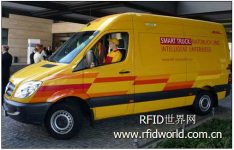
DHL announced the initial results of the SmartTruck project-to achieve cost, time and CO2 reduction
DHL, the global parcel express service department of logistics giant Deutsche Post DHL, held a press conference in Berlin on September 22 to announce the initial results of its SmartTruck project. The SmartTruck project integrates RFID into DHL’s express trucks to process packages faster. DHL stated that the company has achieved multiple expected goals. However, the project has not yet been able to enter the application stage due to the inability of the on-board RFID reader to achieve a 100% read rate.
“We are very pleased that SmartTruck has passed the test in the technical field,” said Keith Ulrich, DHL’s director of technology and innovation management. “We have achieved reductions in fuel consumption and carbon monoxide emissions. Moreover, the punctuality of parcel collection and express delivery has also been greatly improved. Up”.
In addition, Ulrich said, thanks to the use of RFID technology, customers can not only track the exact delivery route of the package, but also receive notification of the expected delivery time through SMS text messages.
However, Ulrich warned that DHL needs to further optimize the system before adopting this technology on a wider scale to improve the system’s ability to read passive UHF RFID tags for packages. The project used two modified Mercedes-Benz Sprinter express vehicles.

SmartTruck
“We found that in some cases, RFID technology cannot achieve a satisfactory 100% read rate. Therefore, we are now launching another project to improve RFID technology,” Ulrich explained.
DHL’s SmartTruck project not only uses RFID technology, but also a navigation system that uses real-time traffic data to improve route planning. The system can reduce the mileage of express trucks and improve the efficiency of parcel collection and delivery. This technology was developed at the DHL Innovation Center with the assistance of the Federal Ministry of Economics and Technology, the German Aerospace Center (DLR), the German Center for Artificial Intelligence Research (DFKI), Infoware, Motorola and Quintiq.
Starting from April 1st this year, two modified express vehicles from the DHL fleet began to pilot this project in Berlin. Each vehicle is equipped with Symbol (Motorola) XR 480 RFID reader, which is connected to the on-board computer. Neither Motorola nor DHL would disclose the cost of the RFID part of the equipment or project.
“Fixed readers are used in warehouses in most cases,” said Ward Vermoere, Motorola’s account director in charge of the project. “Installing fixed readers on vehicles is quite unique.” The RFID system collects tag data in the truck and connects it to the DHL network through the on-board computer of the vehicle, so that customers can obtain real-time data about the package. Currently, DHL uses barcode scanning to update inventory data.

An XR 480 RFID reader is installed on each truck and connected to the on-board computer
In order to ensure the maximum communication between the tag and the reader, 6 Motorola RFID reader antennas were installed in the cargo storage station of Sprinter vehicles. The steel rack cabinets used to place parcels in the past were replaced with carbon fiber containers to reduce interference caused by metals. In order to reduce the impact of road vibration, the antenna is installed on a special board on the wall of the truck.
The RFID tag is supplied by GM Consult IT, runs at 865-868 MHz, complies with the EPC Gen 2 standard, and is packaged with a UPM Raflatac inlay containing an NXP chip. Currently, the label is manually pasted on the package. If this system is widely adopted, project director Boris Paul said, DHL will automatically label the package when it receives it.
According to Paul, the reader accurately tracks the packages when some packages are taken out of the truck. It is this situation frequently encountered by courier drivers that causes the reader to fail to achieve a 100% reading rate. When the driver hurriedly took out a stack of letters of different sizes from the car, Paul said that it is often difficult for the device to scan the contents.
“You can imagine that in the express delivery industry, many items are packed in letters, such as CDs or books, and when drivers arrive at a place, they just quickly take out the letter and leave,” Paul explained.
The fast industry has also changed in the past two or three years. Paul said this is also one of the reasons for label reading problems. DHL sorting points can often see flat-screen TVs or full boxes of beer. Beer or other water-bearing objects attract RF signals, while TVs and other metal-bearing objects reflect RF signals. Therefore, Paul claims that these large packages containing water or gold will affect the label signal and make it difficult to identify in the truck.
DHL is optimistic about this and is currently cooperating with the Fraunhofer Institute in Germany to solve this problem.
Although Paul did not disclose the timetable for DHL trucks to adopt RFID on a wider scale, he said that the company is now evaluating the use of this technology to achieve some goals related to the express delivery industry. Once adopted, RFID tags may replace existing barcodes and scanners to track packages, simplifying the process and saving time.
As part of another project to improve the performance of readers, DHL also plans to test a “light-on-delivery” system. The system is integrated with the truck-mounted computer to identify which packages will be sent in the next stage. The system will use RFID to locate specific packages on the truck shelves, and lights installed on the shelves at certain intervals will guide the driver to find the correct package, thereby speeding up the express delivery process and reducing manual errors.
According to Paul, Deutsche Post DHL hopes that the SmartTruck project will help the company achieve its goal set in April 2008, to increase operational CO2 efficiency by 10% by 2012 and 30% by 2020.



